
Illustrative Math Alignment: Grade 6 Unit 8
Data Sets and Distributions
Lesson 1: Got Data?
Use the following Media4Math resources with this Illustrative Math lesson.
| Thumbnail Image | Title | Body | Curriculum Nodes |
|---|---|---|---|

|
Math Example--Measures of Central Tendency--Median: Example 5 | Math Example--Measures of Central Tendency--Median: Example 5TopicMeasures of Central Tendency DescriptionThis example demonstrates how to find the median of the following set of numbers: 49, 3, 27, 46, 7, 32, 21, 33, 33. The process involves arranging the numbers from least to greatest and then identifying the middle value. In this case, with an odd number of terms, the median is simply the middle number after sorting, which is 32. |
Data Analysis |
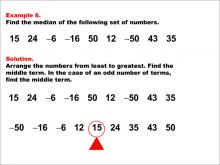
|
Math Example--Measures of Central Tendency--Median: Example 6 | Math Example--Measures of Central Tendency--Median: Example 6TopicMeasures of Central Tendency DescriptionThis example illustrates the process of finding the median for the set of numbers: 15, 24, -6, -16, 50, 12, -50, 43, 35. The solution involves arranging the numbers from least to greatest and then identifying the middle value. With an odd number of terms, the median is simply the middle number after sorting, which in this case is 15. |
Data Analysis |
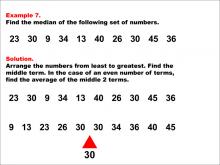
|
Math Example--Measures of Central Tendency--Median: Example 7 | Math Example--Measures of Central Tendency--Median: Example 7TopicMeasures of Central Tendency DescriptionThis example demonstrates finding the median of the following set of numbers: 23, 30, 9, 34, 13, 40, 26, 30, 45, 36. The solution involves arranging the numbers from least to greatest and then identifying the middle value. With an even number of terms, the median is calculated as the average of the two middle terms, resulting in a median of 30. |
Data Analysis |
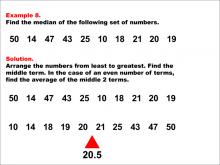
|
Math Example--Measures of Central Tendency--Median: Example 8 | Math Example--Measures of Central Tendency--Median: Example 8TopicMeasures of Central Tendency DescriptionThis example demonstrates how to find the median of the following set of numbers: 50, 14, 47, 43, 25, 10, 18, 21, 20, 19. The process involves arranging the numbers in ascending order and then identifying the middle value. With an even number of terms, the median is calculated as the average of the two middle terms, resulting in a median of 20.5. |
Data Analysis |

|
Math Example--Measures of Central Tendency--Median: Example 9 | Math Example--Measures of Central Tendency--Median: Example 9TopicMeasures of Central Tendency DescriptionThis example illustrates the process of finding the median for the set of numbers: 13, -3, 23, -20, -14, -32, -31, -21, 36, -14. The solution involves arranging the numbers from least to greatest and then identifying the middle value. With an even number of terms, the median is calculated as the average of the two middle terms, resulting in a median of -14. |
Data Analysis |
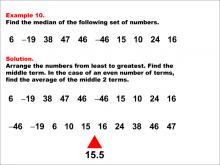
|
Math Example--Measures of Central Tendency--Median: Example 10 | Math Example--Measures of Central Tendency--Median: Example 10TopicMeasures of Central Tendency DescriptionThis example demonstrates finding the median of the following set of numbers: 6, -19, 38, 47, 46, -46, 15, 10, 24, 16. The solution involves arranging the numbers from least to greatest and then identifying the middle value. With an even number of terms, the median is calculated as the average of the two middle terms, resulting in a median of 15.5. |
Data Analysis |
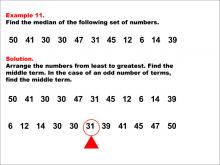
|
Math Example--Measures of Central Tendency--Median: Example 11 | Math Example--Measures of Central Tendency--Median: Example 11TopicMeasures of Central Tendency DescriptionThis example illustrates the process of finding the median for the set of numbers: 50, 41, 30, 30, 47, 31, 45, 12, 6, 14, 39. The solution involves arranging the numbers from least to greatest and then identifying the middle value. With an odd number of terms, the median is simply the middle number after sorting, which is 31. |
Data Analysis |
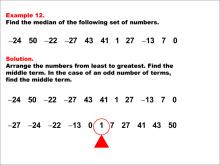
|
Math Example--Measures of Central Tendency--Median: Example 12 | Math Example--Measures of Central Tendency--Median: Example 12TopicMeasures of Central Tendency DescriptionThis example demonstrates finding the median of the following set of numbers: -24, 50, -22, -27, 43, 41, 1, 27, -13, 7, 0. The solution involves arranging the numbers from least to greatest and then identifying the middle value. With an odd number of terms, the median is simply the middle number after sorting, which is 1. |
Data Analysis |
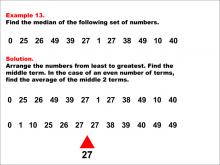
|
Math Example--Measures of Central Tendency--Median: Example 13 | Math Example--Measures of Central Tendency--Median: Example 13TopicMeasures of Central Tendency DescriptionThis example illustrates the process of finding the median for the set of numbers: 0, 25, 26, 49, 39, 27, 1, 27, 38, 49, 10, 40. The solution involves arranging the numbers from least to greatest and then identifying the middle value. With an even number of terms, the median is calculated as the average of the two middle terms, resulting in a median of 27. |
Data Analysis |

|
Math Example--Measures of Central Tendency--Median: Example 14 | Math Example--Measures of Central Tendency--Median: Example 14TopicMeasures of Central Tendency DescriptionThis example demonstrates finding the median of the following set of numbers: 45, 2, 20, 2, 37, 11, 46, 49, 21, 27, 50, 45. The solution involves arranging the numbers from least to greatest and then identifying the middle value. With an even number of terms, the median is calculated as the average of the two middle terms, resulting in a median of 32. |
Data Analysis |
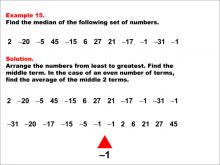
|
Math Example--Measures of Central Tendency--Median: Example 15 | Math Example--Measures of Central Tendency--Median: Example 15TopicMeasures of Central Tendency DescriptionThis example illustrates the process of finding the median for the set of numbers: 2, -20, -5, 45, -15, 6, 27, 21, -17, -1, -31, -1. The solution involves arranging the numbers from least to greatest and then identifying the middle value. With an even number of terms, the median is calculated as the average of the two middle terms, resulting in a median of -1. |
Data Analysis |
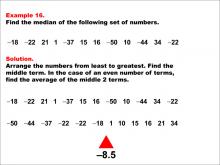
|
Math Example--Measures of Central Tendency--Median: Example 16 | Math Example--Measures of Central Tendency--Median: Example 16TopicMeasures of Central Tendency DescriptionThis example demonstrates finding the median of the following set of numbers: -18, -22, 21, 1, -37, 15, 16, -50, 10, -44, 34, -22. The solution involves arranging the numbers from least to greatest and then identifying the middle value. With an even number of terms, the median is calculated as the average of the two middle terms, resulting in a median of -8.5. |
Data Analysis |
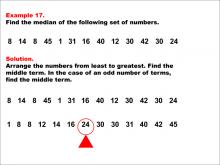
|
Math Example--Measures of Central Tendency--Median: Example 17 | Math Example--Measures of Central Tendency--Median: Example 17TopicMeasures of Central Tendency DescriptionThis example illustrates the process of finding the median for the set of numbers: 8, 14, 8, 45, 1, 31, 16, 40, 12, 30, 42, 30, 24. The solution involves arranging the numbers from least to greatest and then identifying the middle value. With an odd number of terms, the median is simply the middle number after sorting, which is 24. |
Data Analysis |
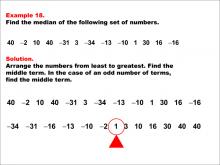
|
Math Example--Measures of Central Tendency--Median: Example 18 | Math Example--Measures of Central Tendency--Median: Example 18TopicMeasures of Central Tendency DescriptionThis example demonstrates finding the median of the following set of numbers: 40, -2, 10, 40, -31, 3, -34, -13, -10, 1, 30, 16, -16. The solution involves arranging the numbers from least to greatest and then identifying the middle value. With an odd number of terms, the median is simply the middle number after sorting, which is 1. |
Data Analysis |
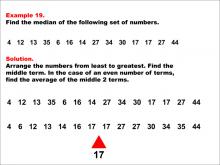
|
Math Example--Measures of Central Tendency--Median: Example 19 | Math Example--Measures of Central Tendency--Median: Example 19TopicMeasures of Central Tendency DescriptionThis example illustrates the process of finding the median for the set of numbers: 4, 12, 13, 35, 6, 16, 14, 27, 34, 30, 17, 17, 27, 44. The solution involves arranging the numbers from least to greatest and then identifying the middle value. With an even number of terms, the median is calculated as the average of the two middle terms, resulting in a median of 17. |
Data Analysis |

|
Math Example--Measures of Central Tendency--Median: Example 20 | Math Example--Measures of Central Tendency--Median: Example 20TopicMeasures of Central Tendency DescriptionThis example demonstrates finding the median of the following set of numbers: 37, 6, 37, 36, 7, 28, 24, 30, 37, 39, 46, 12, 29, 23. The solution involves arranging the numbers from least to greatest and then identifying the middle value. With an even number of terms, the median is calculated as the average of the two middle terms, resulting in a median of 29.5. |
Data Analysis |
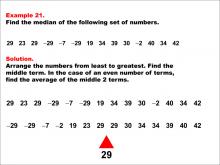
|
Math Example--Measures of Central Tendency--Median: Example 21 | Math Example--Measures of Central Tendency--Median: Example 21TopicMeasures of Central Tendency DescriptionThis example illustrates the process of finding the median for the set of numbers: 29, 23, 29, -29, -7, -29, 19, 34, 39, 30, -2, 40, 34, 42. The solution involves arranging the numbers from least to greatest and then identifying the middle value. With an even number of terms, the median is calculated as the average of the two middle terms, resulting in a median of 29. |
Data Analysis |
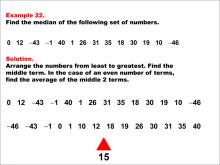
|
Math Example--Measures of Central Tendency--Median: Example 22 | Math Example--Measures of Central Tendency--Median: Example 22TopicMeasures of Central Tendency DescriptionThis example demonstrates finding the median of the following set of numbers: 0, 12, -43, -1, 40, 1, 26, 31, 35, 18, 30, 19, 10, -46. The solution involves arranging the numbers from least to greatest and then identifying the middle value. With an even number of terms, the median is calculated as the average of the two middle terms, resulting in a median of 15. |
Data Analysis |
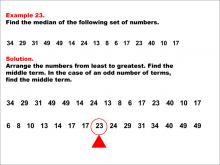
|
Math Example--Measures of Central Tendency--Median: Example 23 | Math Example--Measures of Central Tendency--Median: Example 23TopicMeasures of Central Tendency DescriptionThis example illustrates the process of finding the median for the set of numbers: 34, 29, 31, 49, 49, 14, 24, 13, 8, 6, 17, 23, 40, 10, 17. The solution involves arranging the numbers from least to greatest and then identifying the middle value. With an odd number of terms, the median is simply the middle number after sorting, which is 23. |
Data Analysis |
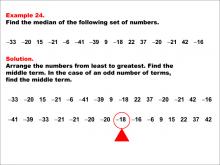
|
Math Example--Measures of Central Tendency--Median: Example 24 | Math Example--Measures of Central Tendency--Median: Example 24TopicMeasures of Central Tendency DescriptionThis example demonstrates finding the median of the following set of numbers: -33, -20, 15, -21, -6, -41, -39, 9, -18, 22, 37, -20, -21, 42, -16. The solution involves arranging the numbers from least to greatest and then identifying the middle value. With an odd number of terms, the median is simply the middle number after sorting, which is -18. |
Data Analysis |
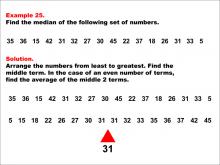
|
Math Example--Measures of Central Tendency--Median: Example 25 | Math Example--Measures of Central Tendency--Median: Example 25TopicMeasures of Central Tendency DescriptionThis example illustrates the process of finding the median for the set of numbers: 35, 36, 15, 42, 31, 32, 27, 30, 45, 22, 37, 18, 26, 31, 33, 5. The solution involves arranging the numbers from least to greatest and then identifying the middle value. With an even number of terms, the median is calculated as the average of the two middle terms, resulting in a median of 31. |
Data Analysis |
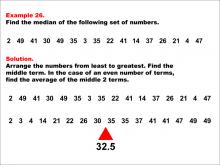
|
Math Example--Measures of Central Tendency--Median: Example 26 | Math Example--Measures of Central Tendency--Median: Example 26TopicMeasures of Central Tendency DescriptionThis example demonstrates finding the median of the following set of numbers: 2, 49, 41, 30, 49, 35, 3, 35, 22, 41, 14, 37, 26, 21, 4, 47. The solution involves arranging the numbers from least to greatest and then identifying the middle value. With an even number of terms, the median is calculated as the average of the two middle terms, resulting in a median of 32.5. |
Data Analysis |

|
Math Example--Measures of Central Tendency--Median: Example 27 | Math Example--Measures of Central Tendency--Median: Example 27TopicMeasures of Central Tendency DescriptionThis example illustrates the process of finding the median for the set of numbers: 3, -43, 39, 29, 0, -23, 16, -35, 3, 32, -45, 2, -50, 7, 40, 24. The solution involves arranging the numbers from least to greatest and then identifying the middle value. With an even number of terms, the median is calculated as the average of the two middle terms, resulting in a median of 3. |
Data Analysis |
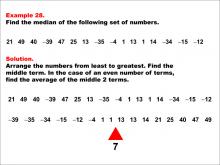
|
Math Example--Measures of Central Tendency--Median: Example 28 | Math Example--Measures of Central Tendency--Median: Example 28TopicMeasures of Central Tendency DescriptionThis example demonstrates finding the median of the following set of numbers: 21, 49, 40, -39, 47, 25, 13, -35, -4, 1, 13, 1, 14, -34, -15, -12. The solution involves arranging the numbers from least to greatest and then identifying the middle value. With an even number of terms, the median is calculated as the average of the two middle terms, resulting in a median of 7. |
Data Analysis |
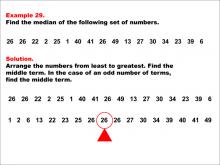
|
Math Example--Measures of Central Tendency--Median: Example 29 | Math Example--Measures of Central Tendency--Median: Example 29TopicMeasures of Central Tendency DescriptionThis example illustrates the process of finding the median for the set of numbers: 26, 26, 22, 2, 25, 1, 40, 41, 26, 49, 13, 27, 30, 34, 23, 39, 6. The solution involves arranging the numbers from least to greatest and then identifying the middle value. With an odd number of terms, the median is simply the middle number after sorting, which is 26. |
Data Analysis |

|
Math Example--Measures of Central Tendency--Median: Example 30 | Math Example--Measures of Central Tendency--Median: Example 30TopicMeasures of Central Tendency DescriptionThis example demonstrates finding the median of the following set of numbers: 20, 30, 17, -36, 26, 6, 8, -30, -21, 0, 42, -19, -34, 39, 6, -18, 24. The solution involves arranging the numbers from least to greatest and then identifying the middle value. With an odd number of terms, the median is simply the middle number after sorting, which is 6. |
Data Analysis |
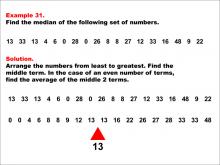
|
Math Example--Measures of Central Tendency--Median: Example 31 | Math Example--Measures of Central Tendency--Median: Example 31TopicMeasures of Central Tendency DescriptionThis example illustrates the process of finding the median for the set of numbers: 13, 33, 13, 4, 6, 0, 28, 0, 26, 8, 8, 27, 12, 33, 16, 48, 9, 22. The solution involves arranging the numbers from least to greatest and then identifying the middle value. With an even number of terms, the median is calculated as the average of the two middle terms, resulting in a median of 13. |
Data Analysis |
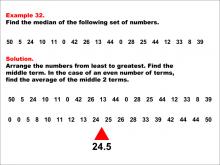
|
Math Example--Measures of Central Tendency--Median: Example 32 | Math Example--Measures of Central Tendency--Median: Example 32TopicMeasures of Central Tendency DescriptionThis example demonstrates finding the median of the following set of numbers: 50, 5, 24, 10, 11, 0, 42, 26, 13, 44, 0, 28, 25, 44, 12, 33, 8, 39. The solution involves arranging the numbers from least to greatest and then identifying the middle value. With an even number of terms, the median is calculated as the average of the two middle terms, resulting in a median of 24.5. |
Data Analysis |

|
Math Example--Measures of Central Tendency--Median: Example 33 | Math Example--Measures of Central Tendency--Median: Example 33TopicMeasures of Central Tendency DescriptionThis example illustrates the process of finding the median for the set of numbers: -22, 30, -39, 46, 50, 27, -42, -15, 15, -14, 47, -31, 21, -2, -27, -9, -22, -9. The solution involves arranging the numbers from least to greatest and then identifying the middle value. With an even number of terms, the median is calculated as the average of the two middle terms, resulting in a median of -4.5. |
Data Analysis |

|
Math Example--Measures of Central Tendency--Median: Example 34 | Math Example--Measures of Central Tendency--Median: Example 34TopicMeasures of Central Tendency DescriptionThis example demonstrates finding the median of the following set of numbers: -4, -44, 24, -48, 35, -3, 50, 34, -32, 42, 11, 22, -49, -4, -31, 41, 30, 17. The solution involves arranging the numbers from least to greatest and then identifying the middle value. With an even number of terms, the median is calculated as the average of the two middle terms, resulting in a median of 14. |
Data Analysis |
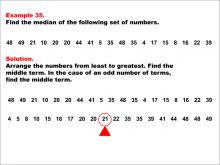
|
Math Example--Measures of Central Tendency--Median: Example 35 | Math Example--Measures of Central Tendency--Median: Example 35TopicMeasures of Central Tendency DescriptionThis example illustrates the process of finding the median for the set of numbers: 48, 49, 21, 10, 20, 20, 44, 41, 5, 35, 48, 35, 4, 17, 15, 8, 16, 22, 39. The solution involves arranging the numbers from least to greatest and then identifying the middle value. With an odd number of terms, the median is simply the middle number after sorting, which is 21. |
Data Analysis |
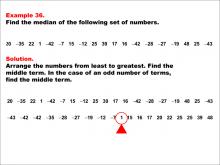
|
Math Example--Measures of Central Tendency--Median: Example 36 | Math Example--Measures of Central Tendency--Median: Example 36TopicMeasures of Central Tendency DescriptionThis example demonstrates finding the median of the following set of numbers: 20, -35, 22, 1, -42, -7, 15, -12, 25, 39, 17, 16, -42, -28, -27, -19, 48, 25, -43. The solution involves arranging the numbers from least to greatest and then identifying the middle value. With an odd number of terms, the median is simply the middle number after sorting, which is 1. |
Data Analysis |
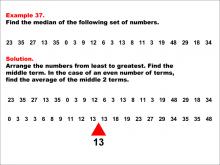
|
Math Example--Measures of Central Tendency--Median: Example 37 | Math Example--Measures of Central Tendency--Median: Example 37TopicMeasures of Central Tendency DescriptionThis example illustrates the process of finding the median for the set of numbers: 3, 1, 4, 2, 5. The solution involves arranging the numbers from least to greatest and then identifying the middle value. With an odd number of terms, the median is simply the middle number after sorting, which is 3. |
Data Analysis |
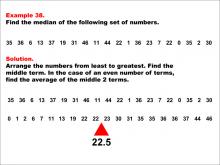
|
Math Example--Measures of Central Tendency--Median: Example 38 | Math Example--Measures of Central Tendency--Median: Example 38TopicMeasures of Central Tendency DescriptionThis example demonstrates finding the median of the following set of numbers: 3, 5, 1, 4, 2. The solution involves arranging the numbers from least to greatest and then identifying the middle value. With an odd number of terms, the median is simply the middle number after sorting, which is 3. |
Data Analysis |
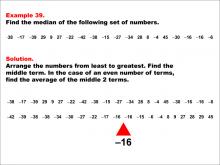
|
Math Example--Measures of Central Tendency--Median: Example 39 | Math Example--Measures of Central Tendency--Median: Example 39TopicMeasures of Central Tendency DescriptionThis example illustrates the process of finding the median for the set of numbers: 2, 5, 7, 10, 12. The solution involves arranging the numbers from least to greatest and then identifying the middle value. With an odd number of terms, the median is simply the middle number after sorting, which is 7. |
Data Analysis |
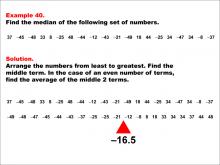
|
Math Example--Measures of Central Tendency--Median: Example 40 | Math Example--Measures of Central Tendency--Median: Example 40TopicMeasures of Central Tendency DescriptionThis example demonstrates the general process of finding the median for a set of numbers. The solution involves arranging the numbers from least to greatest and then identifying the middle value. The procedure differs slightly depending on whether there is an odd or even number of terms in the dataset. |
Data Analysis |

|
Math Example--Measures of Central Tendency--Mode: Example 1 | Math Example--Measures of Central Tendency--Mode: Example 1TopicMeasures of Central Tendency DescriptionThis example showcases a situation of measures of central tendency, where the goal is to identify a key summary measure in a set of data. The image shows a set of numbers with an example of finding the mode. The numbers are arranged from least to greatest, and it concludes that there is no mode. The example demonstrates that in some cases, a data set may not have a mode when no number appears more than once. |
Data Analysis |
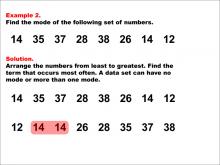
|
Math Example--Measures of Central Tendency--Mode: Example 2 | Math Example--Measures of Central Tendency--Mode: Example 2TopicMeasures of Central Tendency DescriptionThis example showcases a situation of measures of central tendency, where the goal is to identify a key summary measure in a set of data. The image presents a set of numbers with an example of finding the mode. The numbers are sorted, showing that the mode is 14. This example illustrates how to identify the mode when a number appears more frequently than others in a data set. |
Data Analysis |
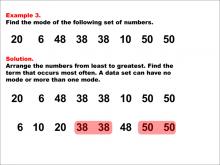
|
Math Example--Measures of Central Tendency--Mode: Example 3 | Math Example--Measures of Central Tendency--Mode: Example 3TopicMeasures of Central Tendency DescriptionThis example showcases a situation of measures of central tendency, where the goal is to identify a key summary measure in a set of data. This image illustrates a set of numbers with an example to find the mode. After sorting, it identifies two modes: 38 and 50. This example demonstrates that a data set can have more than one mode, which occurs when two or more numbers appear with the highest frequency. |
Data Analysis |
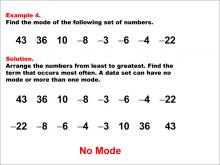
|
Math Example--Measures of Central Tendency--Mode: Example 4 | Math Example--Measures of Central Tendency--Mode: Example 4TopicMeasures of Central Tendency DescriptionThis example showcases a situation of measures of central tendency, where the goal is to identify a key summary measure in a set of data. The image displays a set of numbers with an example for finding the mode. After arranging them, it concludes that there is no mode. This example reinforces the concept that not all data sets have a mode, particularly when each number appears only once in the set. |
Data Analysis |

|
Math Example--Measures of Central Tendency--Mode: Example 5 | Math Example--Measures of Central Tendency--Mode: Example 5TopicMeasures of Central Tendency DescriptionThis example showcases a situation of measures of central tendency, where the goal is to identify a key summary measure in a set of data. Example 5 shows a set of numbers with negative and positive values, highlighting the mode. The example demonstrates that the mode can be found in a data set containing both positive and negative numbers, with 2 being identified as the mode in this case. |
Data Analysis |
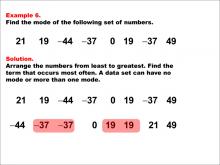
|
Math Example--Measures of Central Tendency--Mode: Example 6 | Math Example--Measures of Central Tendency--Mode: Example 6TopicMeasures of Central Tendency DescriptionThis example showcases a situation of measures of central tendency, where the goal is to identify a key summary measure in a set of data. Example 6 displays a mix of negative and positive numbers with two modes highlighted. The example illustrates that a data set can have multiple modes, even when it contains both positive and negative numbers. In this case, -37 and 19 are identified as the modes. |
Data Analysis |
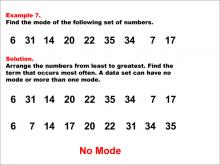
|
Math Example--Measures of Central Tendency--Mode: Example 7 | Math Example--Measures of Central Tendency--Mode: Example 7TopicMeasures of Central Tendency DescriptionThis example showcases a situation of measures of central tendency, where the goal is to identify a key summary measure in a set of data. Example 7 presents a set of numbers with no repeating values; no mode is found. This example reinforces the concept that not all data sets have a mode, particularly when each number in the set appears only once. |
Data Analysis |

|
Math Example--Measures of Central Tendency--Mode: Example 8 | Math Example--Measures of Central Tendency--Mode: Example 8TopicMeasures of Central Tendency DescriptionThis example showcases a situation of measures of central tendency, where the goal is to identify a key summary measure in a set of data. Example 8 includes a set of numbers with one mode highlighted. The numbers are sorted in ascending order, revealing that 8 appears twice, while all other numbers appear only once. This demonstrates how to identify the mode when one number occurs more frequently than others in a data set. |
Data Analysis |
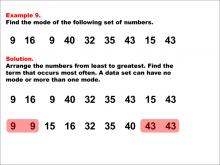
|
Math Example--Measures of Central Tendency--Mode: Example 9 | Math Example--Measures of Central Tendency--Mode: Example 9TopicMeasures of Central Tendency DescriptionThis example showcases a situation of measures of central tendency, where the goal is to identify a key summary measure in a set of data. The image shows an example of finding the mode from a set of numbers. The numbers are arranged from least to greatest, highlighting the most frequent ones. After sorting, it becomes clear that both 9 and 43 appear twice, while all other numbers appear only once. This example demonstrates that a data set can have more than one mode. |
Data Analysis |

|
Math Example--Measures of Central Tendency--Mode: Example 10 | Math Example--Measures of Central Tendency--Mode: Example 10TopicMeasures of Central Tendency DescriptionThis example showcases a situation of measures of central tendency, where the goal is to identify a key summary measure in a set of data. The image presents an example where no mode is found in a set of numbers after sorting them from least to greatest. This demonstrates that not all data sets have a mode, particularly when each number in the set appears only once. |
Data Analysis |
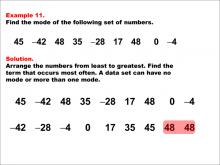
|
Math Example--Measures of Central Tendency--Mode: Example 11 | Math Example--Measures of Central Tendency--Mode: Example 11TopicMeasures of Central Tendency DescriptionThis example showcases a situation of measures of central tendency, where the goal is to identify a key summary measure in a set of data. The image demonstrates finding the mode by arranging numbers in order and identifying the most frequent number. After sorting, it becomes clear that 48 appears twice, while all other numbers appear only once, making 48 the mode of this data set. |
Data Analysis |
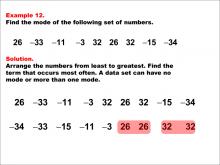
|
Math Example--Measures of Central Tendency--Mode: Example 12 | Math Example--Measures of Central Tendency--Mode: Example 12TopicMeasures of Central Tendency DescriptionThis example showcases a situation of measures of central tendency, where the goal is to identify a key summary measure in a set of data. The image shows an example with multiple modes after sorting a list of numbers and highlighting those that appear most often. After arranging the numbers from least to greatest, it becomes evident that both 26 and 32 appear twice, while all other numbers appear only once. This demonstrates that a data set can have more than one mode. |
Data Analysis |
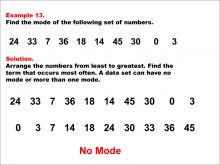
|
Math Example--Measures of Central Tendency--Mode: Example 13 | Math Example--Measures of Central Tendency--Mode: Example 13TopicMeasures of Central Tendency DescriptionThis example showcases a situation of measures of central tendency, where the goal is to identify a key summary measure in a set of data. The image shows a set of numbers with instructions to find the mode. The numbers are arranged from least to greatest, and "No Mode" is indicated. This example reinforces the concept that not all data sets have a mode, particularly when each number in the set appears only once. |
Data Analysis |
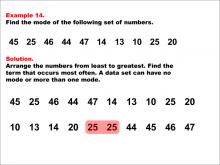
|
Math Example--Measures of Central Tendency--Mode: Example 14 | Math Example--Measures of Central Tendency--Mode: Example 14TopicMeasures of Central Tendency DescriptionThis example showcases a situation of measures of central tendency, where the goal is to identify a key summary measure in a set of data. The image presents a set of numbers with instructions to find the mode. The numbers are sorted, and the mode is highlighted as 25. This example demonstrates how to identify the mode when a number appears more frequently than others in a data set. |
Data Analysis |